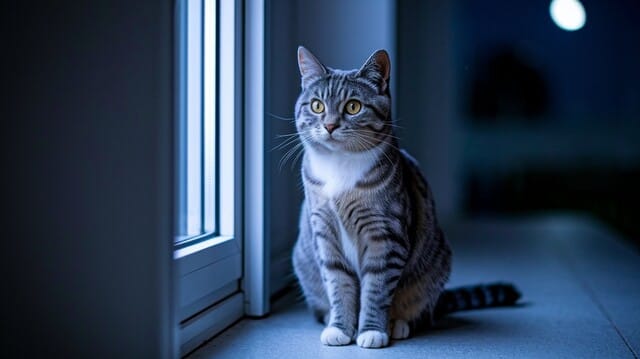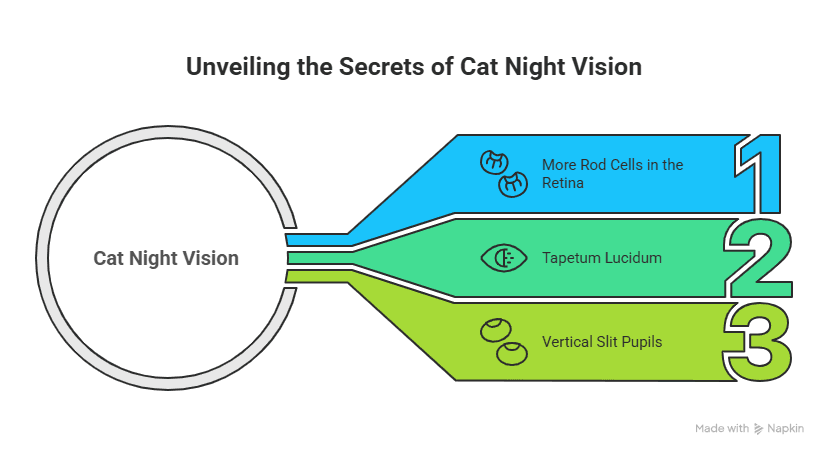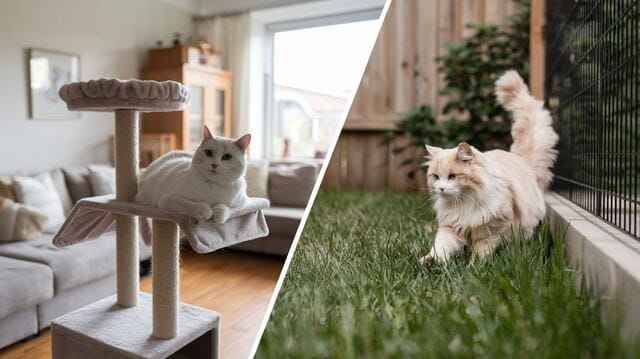
Introduction
It’s 3 a.m. You shuffle groggily down the hall, carefully navigating in the dark so you don’t stub your toe. But your cat? They zoom past you with Olympic-level confidence—leaping, weaving, and pouncing like it’s broad daylight.
This kind of feline night activity makes many cat parents wonder:
Can cats see in total darkness?
While it might seem like your cat is equipped with supernatural powers, the truth is a little more nuanced—and a lot more fascinating. In this article, we’ll break down what cats can (and can’t) see in the dark, the science behind their legendary low-light vision, and how their other senses come into play when the lights go out.
How Cat Vision Compares to Human Vision
Before diving into night vision, it’s important to understand how feline eyes differ from our own.
Cats and humans both rely on the retina, a layer of tissue in the back of the eye made up of two types of photoreceptor cells:
– Rods: Detect motion and light in low-light environments
– Cones: Detect color and detail in well-lit conditions
Here’s how cats and humans stack up:
| Feature | Humans | Cats |
| Rod cells | Lower | 6–8x more (better in dim light) |
| Cone cells | More (better color/detail) | Fewer (weaker color vision) |
| Field of vision | 180° | 200° |
| Night vision | Poor | Excellent |
Cats have traded sharp, colorful daytime vision for night-hunting superpowers, which makes perfect evolutionary sense for a crepuscular predator.
Can Cats See in Total Darkness?
Let’s bust the biggest myth right away:
❌ No, cats cannot see in absolute, total darkness.
But…
✅ Yes, cats can see extremely well in very low light—much better than humans.
They only need about 1/6th of the light we do to see. So, while cats can’t see in a pitch-black cave or a windowless closet with no light source at all, they can thrive in conditions that would leave humans completely blind.
Even the smallest source of ambient light—moonlight, streetlights, or light bouncing off walls—gives cats just enough to activate their night vision magic.
The Anatomy Behind a Cat’s Night Vision

Your cat’s impressive nighttime navigation isn’t just luck—it’s biology. Let’s break down the key features that give cats the edge in the dark:
🧠 1. More Rod Cells in the Retina
Cats’ eyes contain a significantly higher number of rod cells, which are specialized for:
– Detecting motion
– Seeing in dim light
– Noticing movement at a distance
They sacrifice some detail and color accuracy for incredible light sensitivity, making them excellent nighttime hunters.
✨ 2. Tapetum Lucidum: Nature’s Night-Vision Reflector
This shiny layer behind the retina reflects light back through the eye, giving it a second chance to hit the rod cells. Think of it as built-in night vision enhancement.
It’s also why your cat’s eyes glow in the dark when caught by headlights or flash photography. That glow isn’t just eerie—it’s functional.
👁 3. Vertical Slit Pupils
Unlike humans, who have round pupils, cats have vertical slit pupils that can:
– Open extremely wide in low light
– Contract into narrow slits in bright light
This helps them control how much light enters the eye with incredible precision—essential for switching between day naps and night prowling.
So… How Well Can Cats See at Night, Really?
In practical terms, cats can see:
– Clearly and comfortably in near-dark environments
– Movement up to six times better than humans
– Objects and prey even when visibility is minimal
However, their vision isn’t perfect. Cats still struggle to:
– See fine detail (their close-up vision is a bit blurry)
– See bright colors (especially reds and greens)
Their night vision is all about detecting shapes, shadows, and movement—not reading fine print or admiring sunsets.
Do Cats Need Any Light at All?
Yes. Despite the myth, cats cannot function in total darkness.
They need at least some ambient light, like:
– Moonlight through a window
– Light from an adjoining room
– Glow from outside street lamps
If the room is pitch-black, your cat won’t be able to see. But they’ll still get around, thanks to other incredible senses.
How Cats Navigate in the Dark Without Vision
Even when it’s too dark to see, your cat still moves like a ninja. That’s because they rely on a multisensory toolkit beyond sight.
🦶 1. Whiskers (Vibrissae)
– Act as motion detectors and air current sensors
– Help judge width of spaces and detect nearby obstacles
– Especially helpful in dark or tight spaces
👂 2. Ultra-Sensitive Hearing
– Can detect high-frequency sounds up to 65,000 Hz
– Pinpoint movement with directional accuracy
– Can hear small prey rustling or walking—behind walls, even!
🐾 3. Paws & Pads
– Rich in nerve endings
– Feel vibrations through floors
– Help with balance and detecting movement below them
🧠 4. Spatial Memory
– Cats remember layout and patterns
– Allows them to move through familiar spaces with ease—even in darkness
Should You Leave a Light on for Your Cat at Night?
In most cases, no—cats don’t need it. Your average healthy adult cat can navigate your home in near-total darkness just fine.
But in some cases, a small night light can help, such as:
– For senior cats who may have declining vision or joint issues
– If you’ve recently rearranged furniture
– Near litter boxes or food areas, especially in new environments
– For kittens, who may be less confident in the dark
Soft plug-in nightlights are a great way to help without overwhelming your cat’s sensitive eyes.
Do Kittens See Well in the Dark?
Not right away.
Kittens are born with their eyes closed, and even once they open (~7–10 days old), their vision develops gradually.
– By 2 weeks: they begin seeing blurry light and movement
– By 8 weeks: vision improves, but still developing
– By 3–4 months: night vision is near adult levels
So if you’ve got a young kitten, dim lighting at night might help them feel safer and more oriented as they adjust.
FAQs
Why do my cat’s eyes glow in the dark?
That glow comes from the tapetum lucidum, a reflective layer that enhances low-light vision. It bounces light back through the retina—hence the spooky shine.
Can cats see better than dogs in the dark?
Yes! While dogs also have good night vision, cats have superior low-light vision due to more rod cells and better motion sensitivity.
Is my cat afraid of the dark?
Most cats aren’t—but sudden noises or unfamiliar spaces can make them anxious in the dark. If your cat seems stressed, try a nightlight or provide a cozy hiding spot.
Also Read - Why Does My Cat Lay on My Clothes? 6 Surprising Reasons Behind the Cozy Habit
Conclusion
So, can cats see in total darkness?
Not completely—but they come pretty close.
While they can’t function in absolute darkness, cats are equipped with one of nature’s most advanced low-light vision systems. With more rod cells, reflective eyes, and super-sensitive pupils, they need only a sliver of light to see what we can’t.
And when light fails? Their whiskers, hearing, and memory kick in—making them silent, stealthy, and utterly fascinating creatures of the night.
Next time you see your cat confidently prowling through a dark hallway, remember: they may not have night vision goggles… but they might be the next best thing.




